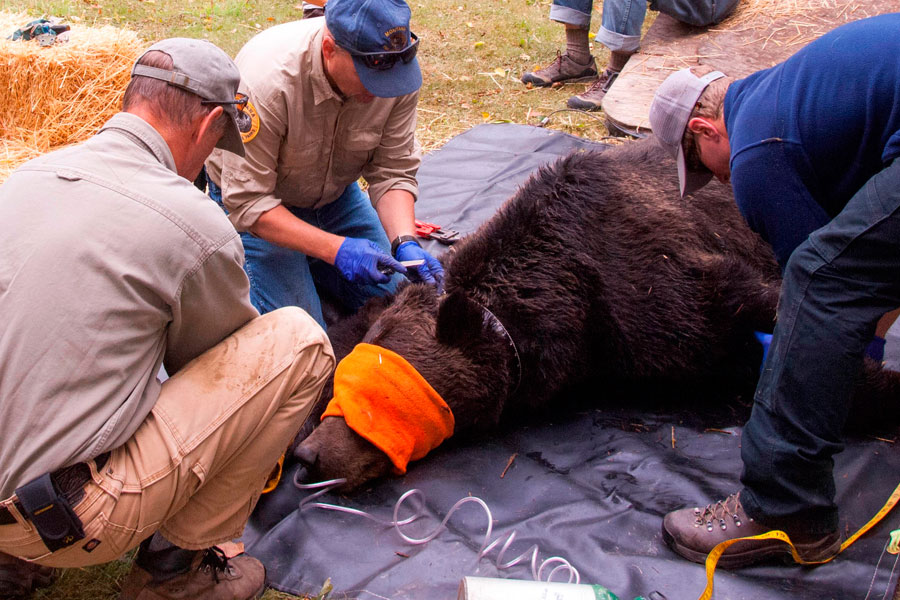With Plan in Place, Future of Grizzly Recovery Remains Uncertain
Commissioners adopt conservation plan to keep 1,000 grizzlies in Northwest Montana
By Tristan Scott
Montana wildlife commissioners recently adopted a grizzly bear conservation plan to maintain the Northern Continental Divide Ecosystem population — the largest in the Lower 48 — at current numbers even if the species loses its federal protections.
Despite the commission-approved plan, it’s a path to recovery tinged with uncertainty as federal officials decide whether to appeal the most recent stumbling block encountered by a delisting plan for a separate recovery population of grizzlies near Yellowstone National Park.
The decision by Montana’s Fish, Wildlife and Parks Commission came as state and federal officials have been trying to demonstrate that enough regulations are in place to prevent bears from sliding toward extinction if they lose their threatened species status.
The plan establishes a threshold of at least 800 grizzlies across a 16,000-square-mile expanse of Northwest Montana, but officials have pledged to manage the population in a way that maintains its current level of roughly 1,000 bears in order to provide a protective cushion.
Grizzlies in the Lower 48 are federally protected as a threatened species, but their management would revert to state control if those protections are lifted. Efforts by federal officials to do so stalled in September, when a federal judge in Missoula reversed a U.S. Interior Department decision that would have allowed hunting of the animals in areas around Yellowstone National Park.
U.S. Fish and Wildlife Service (USFWS) officials had also hoped to start removing Northern Continental Divide Ecosystem grizzly bears from the endangered species list this year, a move that would also allow people to hunt the animals. However, according to USFWS bear recovery coordinator Hillary Cooley, those efforts are now on hold because of the ongoing litigation over delisting grizzly bears in the Greater Yellowstone Ecosystem.
The Yellowstone region includes portions of Montana, Wyoming and Idaho and is home to the second largest group of bears in the Lower 48 with about 700 bears.
The USFWS and the Department of Justice must decide by Dec. 21 whether to appeal the latest defeat of its Greater Yellowstone Ecosystem delisting. If the federal government doesn’t appeal, grizzly managers face difficult choices for the future.
At a recent meeting of the Interagency Grizzly Bear Committee, Cooley said the agency would wait until its court-ordered deadline to announce whether or not it would appeal.
Despite their federally protected status, bears from both populations are routinely killed in vehicle collisions, as well as during run-ins with hunters or following attacks on livestock.
This year, a record 51 grizzly bears were removed from the Northern Continental Divide Ecosystem’s population, 17 of which are classified as removals due to “vehicle collisions,” meaning either the bears were killed in collisions, or orphaned cubs were rehomed or euthanized.
The year’s total is the most on record for the Northern Continental Divide Ecosystem, a sprawling region that includes Glacier National Park, portions of the Flathead and Blackfeet Indian reservations, parts of five national forests, Bureau of Land Management lands, as well as state and private lands.
Ten were removed by government biologists; 36 were human-caused, which includes bears shot during run-ins with hunters; four were natural deaths and one was undetermined.
But U.S. District Court Judge Dana L. Christensen wrote in a 48-page order restoring protections to the Yellowstone bears that the case was “not about the ethics of hunting, and it is not about solving human- or livestock-grizzly conflicts.” Instead, the ruling was based on his determination that the U.S. Fish and Wildlife Service had illegally failed to consider how removing the Yellowstone bears from the endangered species list would affect other protected grizzly populations, and that its analysis of future threats to the bears was “arbitrary and capricious.”
“The Service appropriately recognized that the population’s genetic health is a significant factor demanding consideration,” Christensen wrote. “However, it misread the scientific studies it relied upon, failing to recognize that all evidence suggests that the long-term viability of the Greater Yellowstone grizzly is far less certain absent new genetic material.”
Agency officials have stated they stand behind their finding that the Yellowstone grizzly is biologically recovered and no longer requires protection.